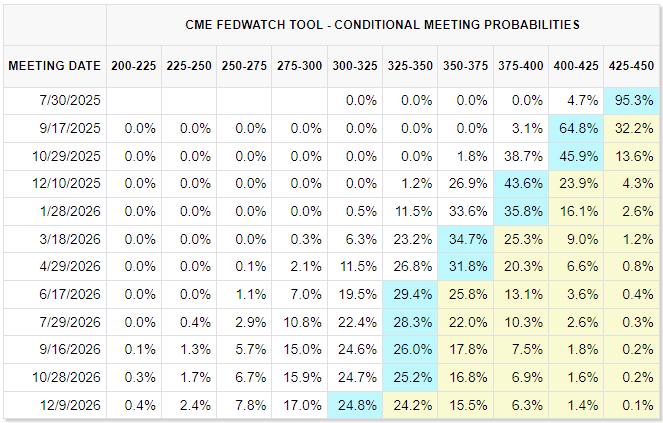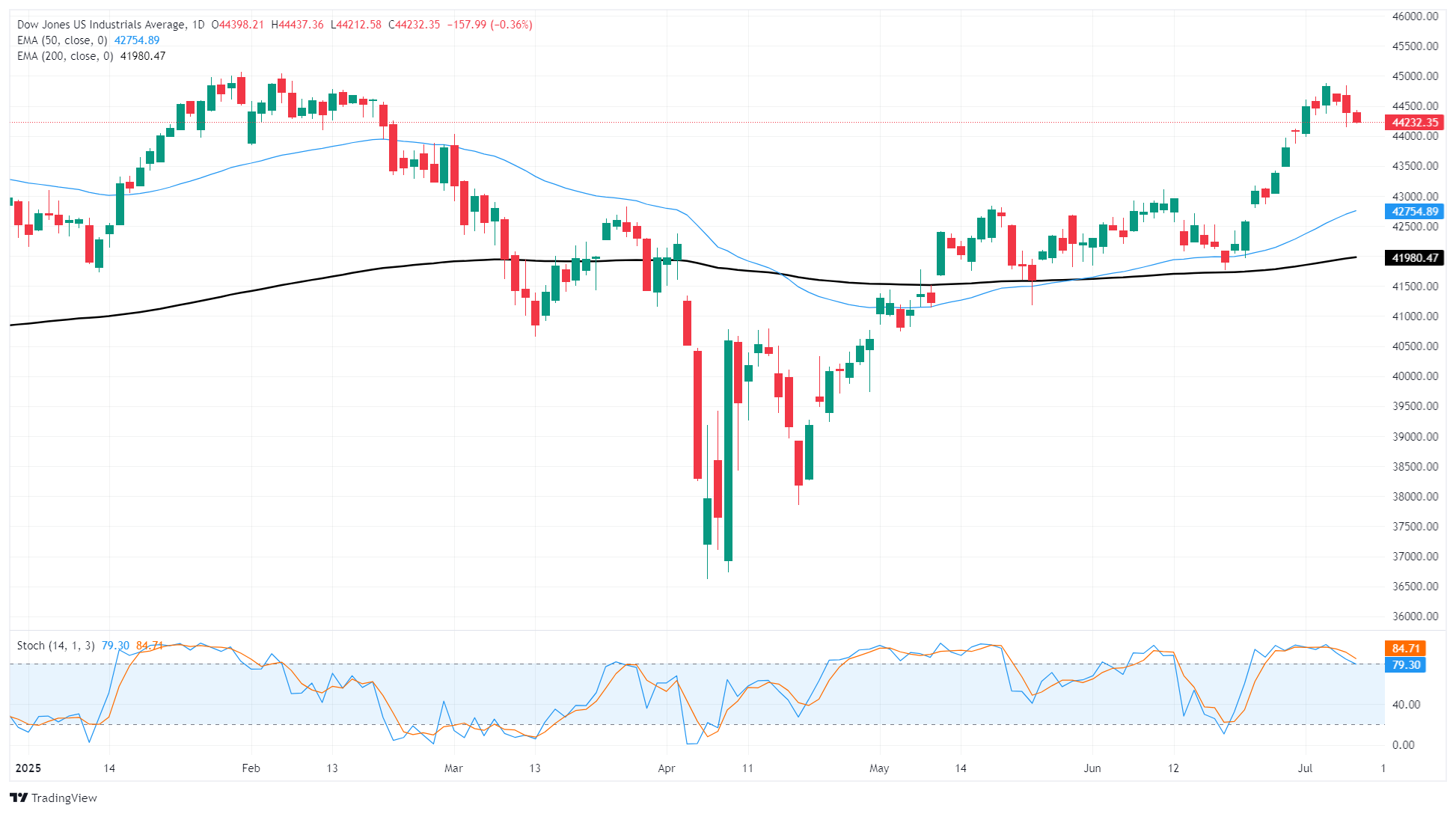Created
: 2025.07.09














![]() 2025.07.09 02:34
2025.07.09 02:34
The Dow Jones Industrial Average (DJIA) struggled to maintain its balance on Tuesday, churning chart paper near 44,350 as the Trump administration angles to keep the pressure on trade talks. President Trump announced additional tariffs of 25% on all imports from South Korea and Japan, set to come into effect on August 1 alongside the twice-delayed reciprocal tariffs announced in early April.
Donald Trump has listed 14 countries that will face additional tariffs on August 1 if trade deals aren't secured by that date. In echoes of previous warnings delivered by Trump himself, the August 1 deadline for reciprocal tariffs is set in stone and won't be delayed or suspended. The exact same cautionary statement was made by Trump as recently as last week, regarding the July 9 reciprocal tariff deadline, which has since been delayed or suspended.
Economic data remains limited throughout the week, giving investors some room to breathe on the data front following last week's tumultuous labor data dump. The Meeting Minutes from the Federal Reserve's (Fed) latest rate discussions will be released on Wednesday, giving market participants a closer look at how near or far the Fed might be from delivering its next rate cut. As trade talk continues to heat up while also getting kicked further down the road, the odds of a quarter-point rate cut are looking less like a sure thing. According to the CME's FedWatch tool, the chances of a push to October are rising in rate markets.

A fresh bout of technical weakness has dragged the Dow Jones Industrial Average back below 44,400 following a strong bullish performance through the last third of June. The major equity index peaked near 44,800, failing to breach all-time highs north of the 45,000 handle.
Despite a near-term pivot into the bearish side, the Dow remains firmly planted in bull country, trading far above the 200-day Exponential Moving Average (EMA) 42,460. A continued grind into the low side could be on the cards with technical oscillators still pinned in overbought territory, but near-term declines will likely crystallize into new buying opportunities.

The Dow Jones Industrial Average, one of the oldest stock market indices in the world, is compiled of the 30 most traded stocks in the US. The index is price-weighted rather than weighted by capitalization. It is calculated by summing the prices of the constituent stocks and dividing them by a factor, currently 0.152. The index was founded by Charles Dow, who also founded the Wall Street Journal. In later years it has been criticized for not being broadly representative enough because it only tracks 30 conglomerates, unlike broader indices such as the S&P 500.
Many different factors drive the Dow Jones Industrial Average (DJIA). The aggregate performance of the component companies revealed in quarterly company earnings reports is the main one. US and global macroeconomic data also contributes as it impacts on investor sentiment. The level of interest rates, set by the Federal Reserve (Fed), also influences the DJIA as it affects the cost of credit, on which many corporations are heavily reliant. Therefore, inflation can be a major driver as well as other metrics which impact the Fed decisions.
Dow Theory is a method for identifying the primary trend of the stock market developed by Charles Dow. A key step is to compare the direction of the Dow Jones Industrial Average (DJIA) and the Dow Jones Transportation Average (DJTA) and only follow trends where both are moving in the same direction. Volume is a confirmatory criteria. The theory uses elements of peak and trough analysis. Dow's theory posits three trend phases: accumulation, when smart money starts buying or selling; public participation, when the wider public joins in; and distribution, when the smart money exits.
There are a number of ways to trade the DJIA. One is to use ETFs which allow investors to trade the DJIA as a single security, rather than having to buy shares in all 30 constituent companies. A leading example is the SPDR Dow Jones Industrial Average ETF (DIA). DJIA futures contracts enable traders to speculate on the future value of the index and Options provide the right, but not the obligation, to buy or sell the index at a predetermined price in the future. Mutual funds enable investors to buy a share of a diversified portfolio of DJIA stocks thus providing exposure to the overall index.
![]()
Created
: 2025.07.09
![]()
Last updated
: 2025.07.09

FXStreet is a forex information website, delivering market analysis and news articles 24/7.
It features a number of articles contributed by well-known analysts, in addition to the ones by its editorial team.
Founded in 2000 by Francesc Riverola, a Spanish economist, it has grown to become a world-renowned information website.
We hope you find this article useful. Any comments or suggestions will be greatly appreciated.
We are also looking for writers with extensive experience in forex and crypto to join us.
please contact us at [email protected].
Disclaimer:
All information and content provided on this website is provided for informational purposes only and is not intended to solicit any investment. Although all efforts are made in order to ensure that the information is correct, no guarantee is provided for the accuracy of any content on this website. Any decision made shall be the responsibility of the investor and Myforex does not take any responsibility whatsoever regarding the use of any information provided herein.
The content provided on this website belongs to Myforex and, where stated, the relevant licensors. All rights are reserved by Myforex and the relevant licensors, and no content of this website, whether in full or in part, shall be copied or displayed elsewhere without the explicit written permission of the relevant copyright holder. If you wish to use any part of the content provided on this website, please ensure that you contact Myforex.
Myforex uses cookies to improve the convenience and functionality of this website. This website may include cookies not only by us but also by third parties (advertisers, log analysts, etc.) for the purpose of tracking the activities of users. Cookie policy